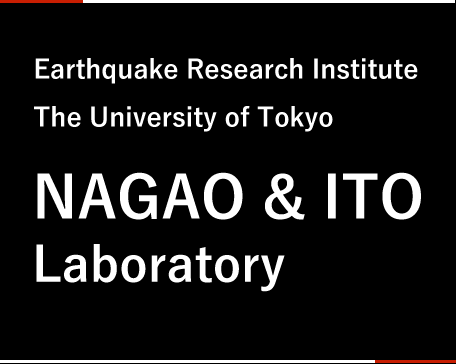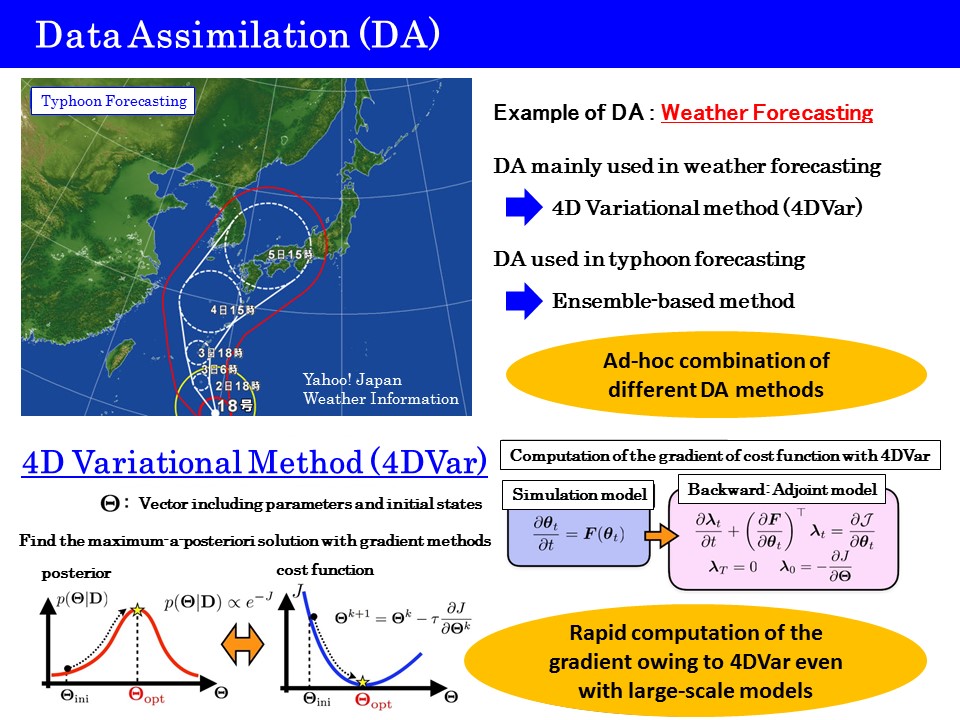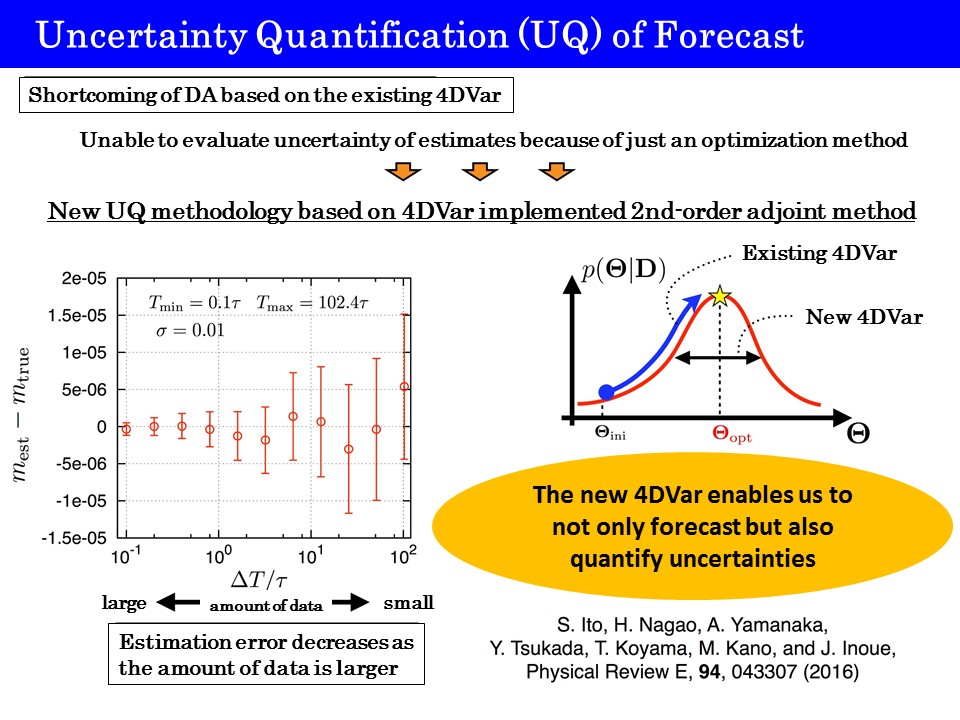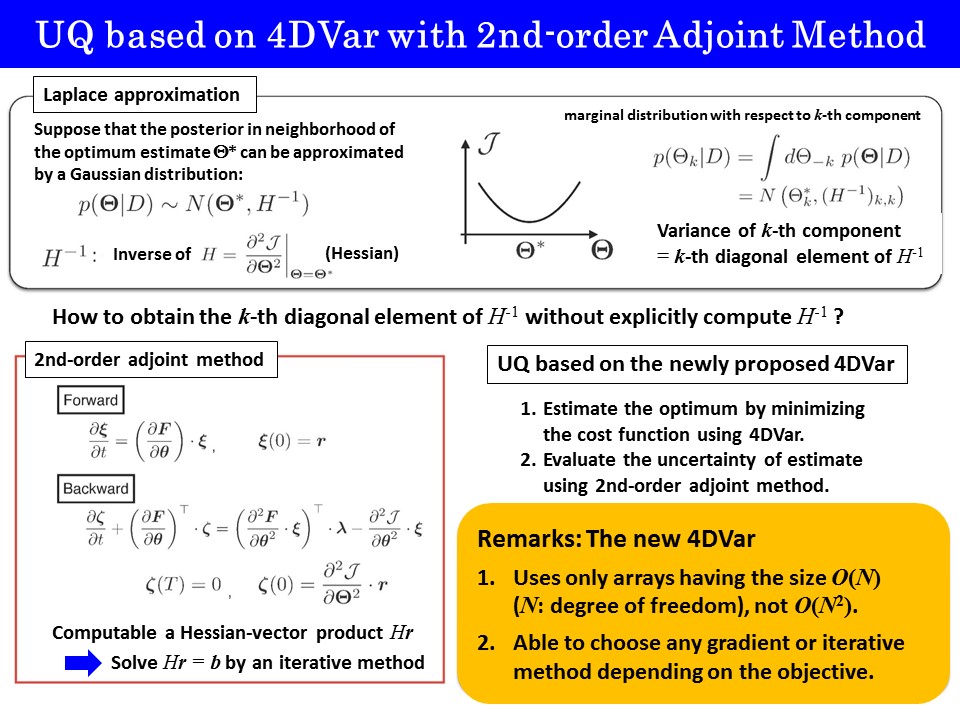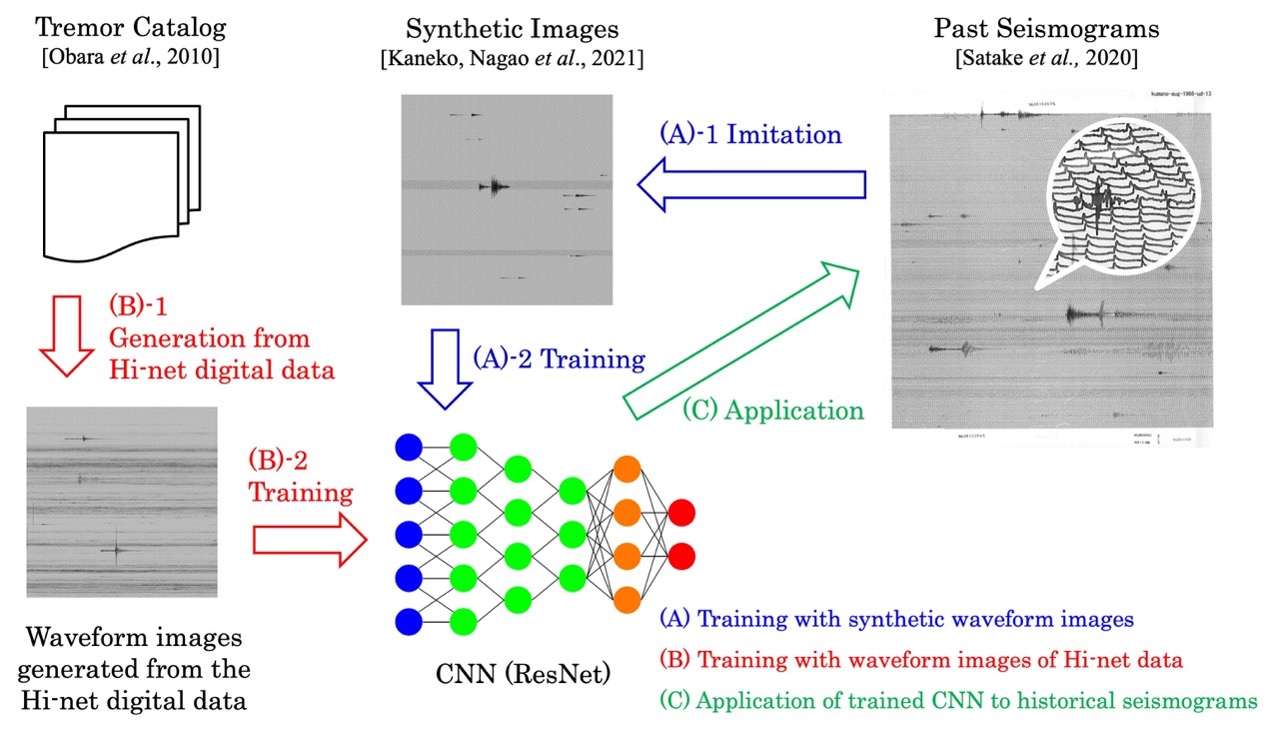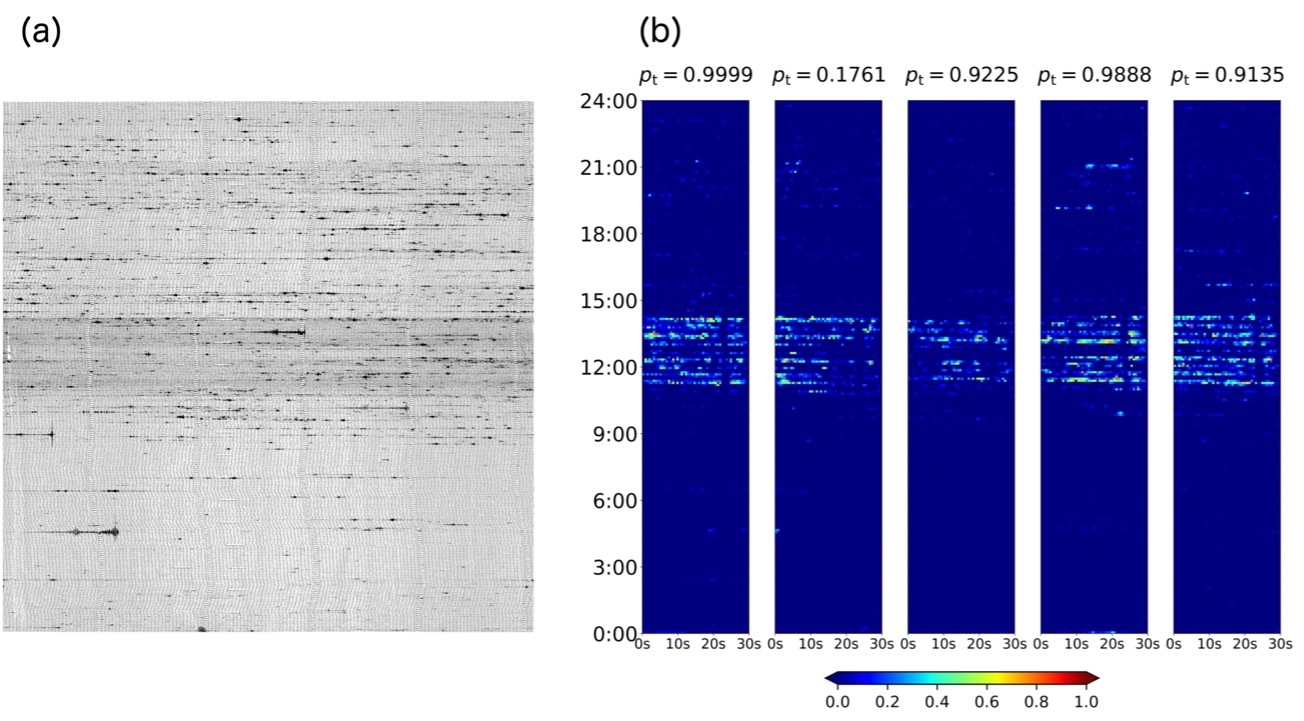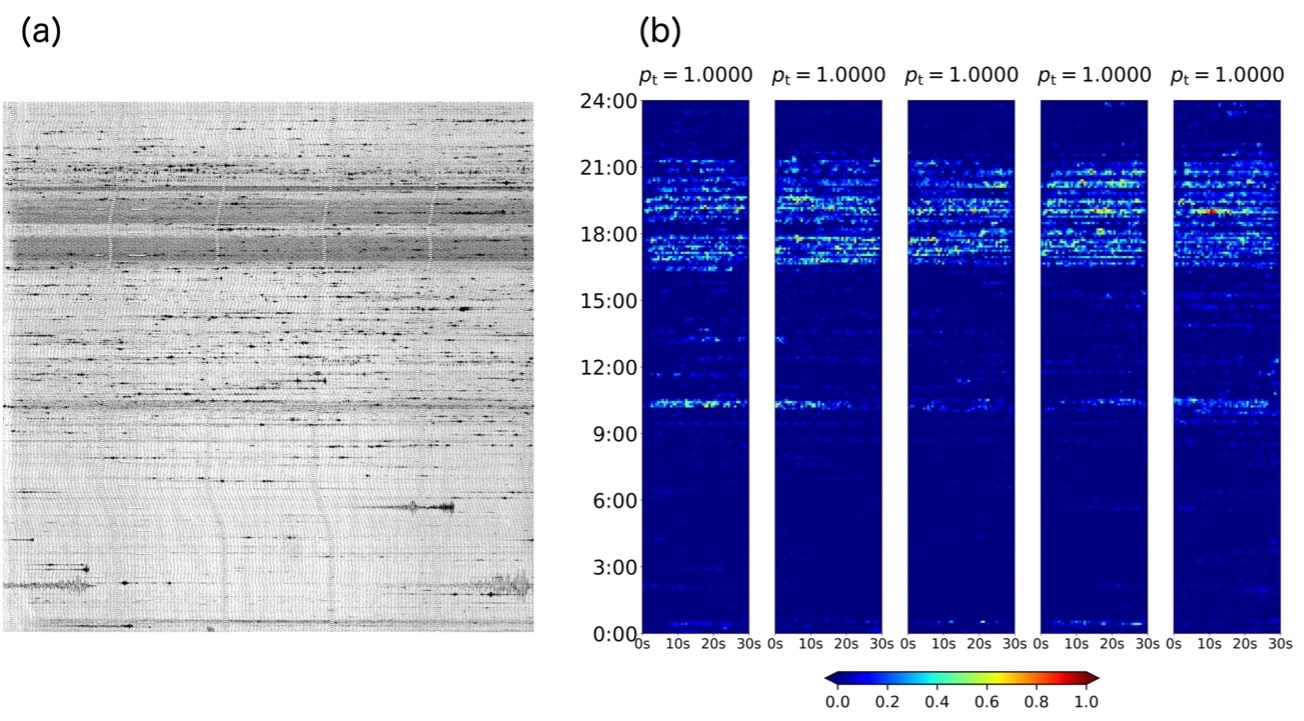Research
- New 4D Variational Method for Data Assimilation
- Deep-Learning Model to Detect Tremors from Past Seismograms
- Phase Prediction Method for Pattern Formation
- Seismic Wavefield Imaging
- Detection of Low-Frequency Tremors in Paper Records from About 50 Years Ago Based on Artificial Intelligence

- Adjoint-based Uncertainty Quantification for Inhomogeneous Friction on a Slow-slipping Fault

- Seismic-phase Detection Using Multiple Deep Learning Models for Global and Local Representations of Waveforms

New 4D Variational Method for Data Assimilation
Data assimilation (DA) is a computational method that integrates numerical simulation models and observational/experimental data based on Bayesian statistics. DA is not only the main technique in the current weather forecasting, but also applied in the various fields of science. The 4D Variational method (4DVar) is usually used when a given simulation model has a large number of freedom like in the weather forecasting. A shortcoming in the existing 4DVar is that it cannot evaluate an uncertainty of the forecast. For example, circles found on an anticipated course of typhoon, which indicate forecasting errors with respect to the location of the eye of typhoon, are estimated by using an ensemble-based method different from 4DVar.
We have successfully developed a new 4DVar methodology implementing a second-order adjoint method, which enables us to not only obtain a forecast but also evaluate its uncertainty. The new 4DVar is practically capable of such unified estimation (i.e., forecasting and uncertainty quantification) even in the cases of large-scale numerical models, avoiding an ad-hoc combination of 4DVar and other ensemble-based methods.
We expect our new method will be applied in various fields of science. See the following paper in detail.
Ito, S., H. Nagao, A. Yamanaka, Y. Tsukada, T. Koyama, M. Kano, and J. Inoue
Data assimilation for massive autonomous systems based on a second-order adjoint method
Phys. Rev. E, 94, 043307, doi:10.1103/PhysRevE.94.043307, 2016.
Deep-Learning Model to Detect Tremors from Past Seismograms
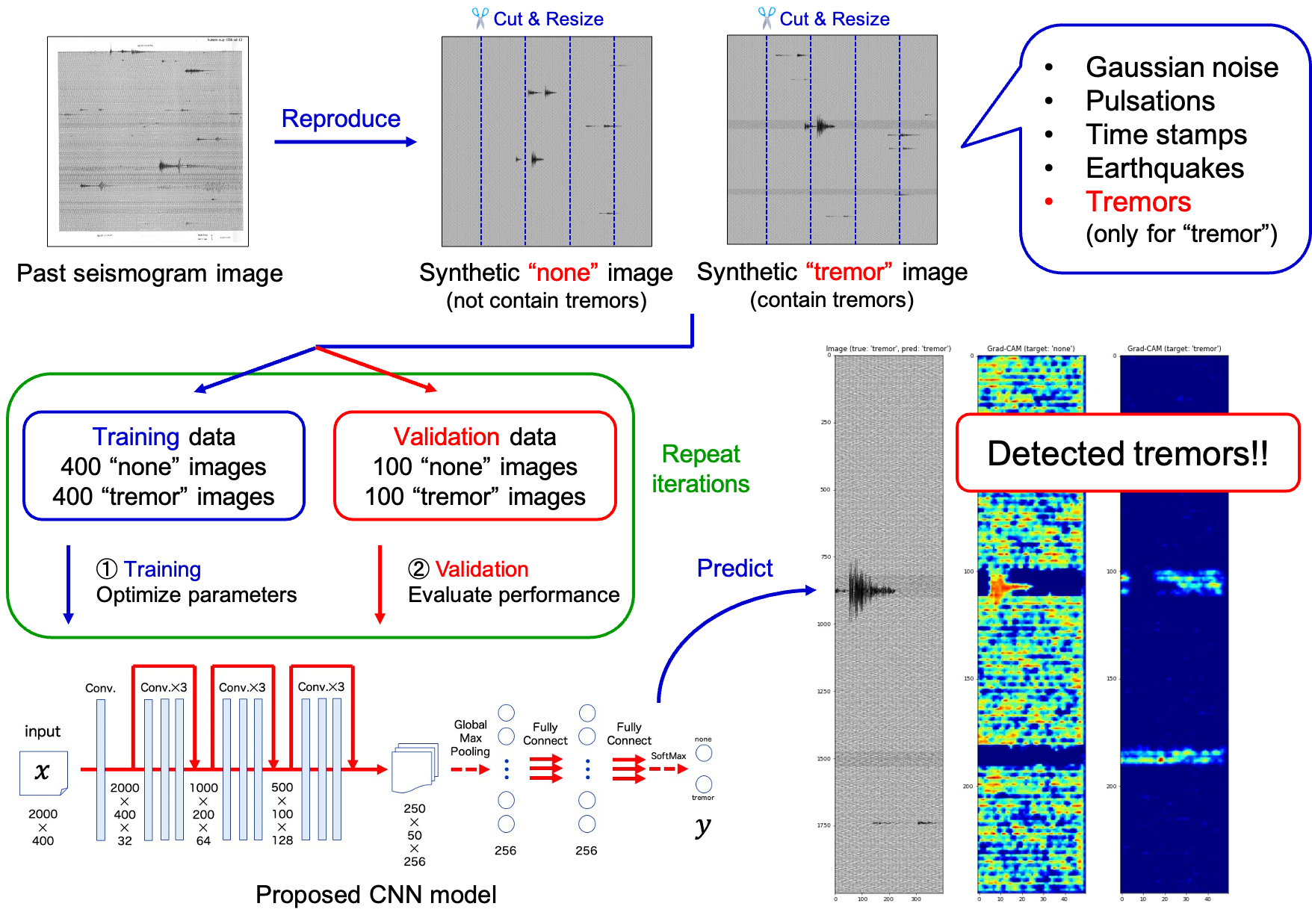
The establishment of dense seismometer arrays in Japan approximately 20 years ago led to the discovery of deep low-frequency tremors, which were weak oscillations categorized as slow earthquakes. Currently, only digital data of the recent 20 years are available for studying tremors. As many studies have indicated the relations between tremors and large earthquakes, it is important to investigate tremors that occurred before establishing the dense seismometer arrays.
We constructed a convolutional neural network (CNN) model to detect tremors from past seismograms which the waveforms of observed oscillations were continuously recorded on paper. In the experiments that we generated synthetic waveform images based on past seismograms and trained the CNN model with them, we verified that our model can correctly detect tremors from input images.
Based on the finding from the experiments, we will conduct training of CNN model with real data and eventually apply the trained model to the past seismograms. See the following paper in detail.
Kaneko, R., H. Nagao, S. Ito, K. Obara, and H. Tsuruoka
Convolutional neural network to detect deep low-frequency tremors from seismic waveform images
Lecture Notes in Computer Science, Vol. 12705, pp. 31-43, doi:10.1007/978-3-030-75015-2_4, 2021.
Phase Prediction Method for Pattern Formation
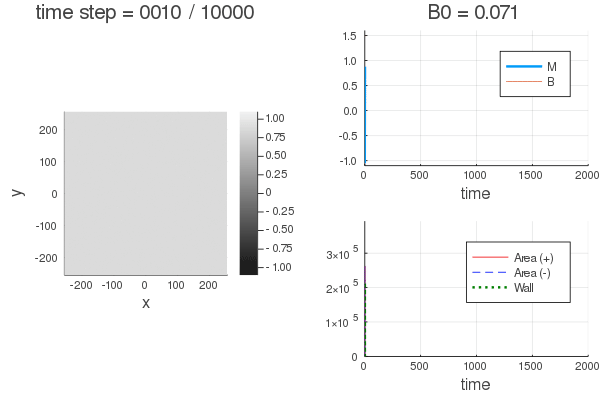
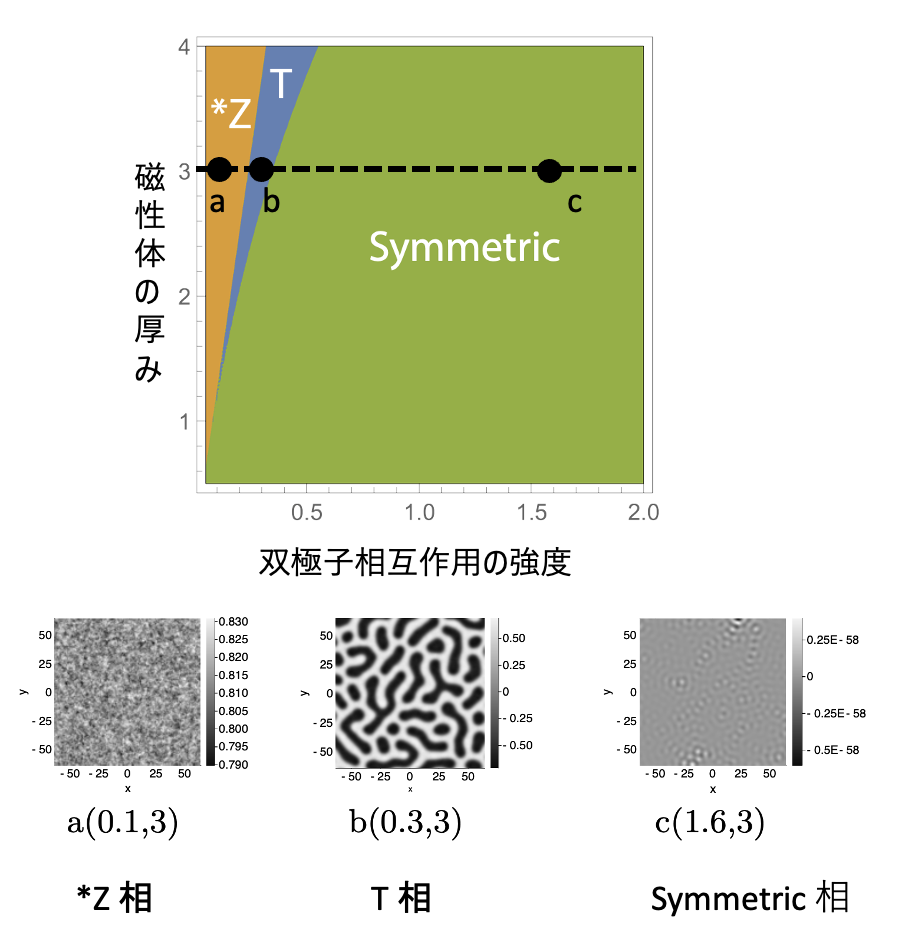
We propose a phase prediction method for pattern formation in a two-dimensional kinetic Ising model with dipole-dipole interactions under the time-dependent Ginzburg-Landau dynamics. Considering the effects of the material thickness by assuming uniformness along the magnetization axis, the model corresponds to thin magnetic materials with long-range repulsive interactions.
We formulate a theoretical basis to understand the effects of the material parameters on the formation of the magnetic domain patterns in terms of the equilibrium equations governing the balance between the linear and nonlinear forces in the equilibrium state. Further, we develop a method for predicting the phase in the equilibrium state achieved after the dynamical evolution of a system with given initial parameters. The analytically hard third-order term is approximated using the restricted phase-space approximation proposed by Anzaki et al., (2015) for the φ4 models.
Although the proposed method does not have perfect concordance with the actual numerical results, it has no arbitrary parameters and functions to tune the prediction. In other words, it is a method with no a priori assumptions of the domain patterns. See the Following paper in detail.
Anzaki, R., S. Ito, H. Nagao, M. Mizumaki, M. Okada, and I. Akai
Phase prediction method for pattern formation in time-dependent Ginzburg-Landau dynamics for kinetic Ising model without a priori assumptions of domain patterns
Phys. Rev. B, 103(9), 094408, doi:10.1103/PhysRevB.103.094408, 2021.
Seismic Wavefield Imaging
Long-period ground motions due to large earthquakes can cause devastating disasters, especially in urbanized areas located on sedimentary basins. To assess and mitigate such damage, it is essential to rapidly evaluate seismic hazards for infrastructures, which can be simulated by seismic response analyses that use waveforms at the base of each infrastructure as an input ground motion. The present study reconstructs the seismic wavefield in the Tokyo metropolitan area located on the Kanto sedimentary basin, Japan, from seismograms of the Metropolitan Seismic Observation network. The obtained wavefield fully explains the observed waveforms in the frequency band of 0.10–0.20 Hz. This is attributed to the seismic wavefield imaging technique proposed by Kano et al. (2017), which implements the replica exchange Monte Carlo method to simultaneously estimate model parameters related to the subsurface structure and source information.
Further investigation shows that the reconstructed seismic wavefield lower than 0.30 Hz is of high quality in terms of variance reduction, which quantifies a misfit in waveforms but that the variance reduction rapidly worsens in higher frequencies. Meanwhile, the velocity response spectra show good agreement with observations up to 0.90 Hz in terms of the combined goodness of fit, which is a measure of misfit in the velocity response spectra. Inputting the reconstructed wavefield into seismic response analyses, we can rapidly assess the overall damage to infrastructures immediately after a large earthquake. See the Following paper in detail.
Kano, M., H. Nagao, K. Nagata, S. Ito, S. Sakai, S. Nakagawa, M. Hori, and N. Hirata
Seismic wavefield imaging of long-period ground motion in the Tokyo Metropolitan area, Japan
J. Geophys. Res. Solid Earth, 122, doi:10.1002/2017JB014276, 2017.
Detection of Low-Frequency Tremors in Paper Records from About 50
Years Ago Based on Artificial Intelligence
Low-frequency tremors, a type of slow earthquake, were discovered in southwest Japan owing to the establishment of spatially-dense seismic observation networks including the High Sensitivity Seismograph Network (Hi-net) in Japan (Obara 2002) after the 1995 Hyogo-ken Nambu Earthquake. These tremors characteristically have much smaller amplitudes and longer durations —sometimes exceeding several hours— than ordinary earthquakes, and have occurred several times a month on average in southwest Japan since 2001. Tremors are considered to occur along the boundary between the Philippine Sea Plate and the upper plate in areas slightly deeper or shallower than ordinary earthquakes, and are therefore expected to be associated with massive plate boundary earthquakes. Current tremor catalogs (e.g., Obara et al., 2010), which list tremor occurrence times and hypocenter locations, contain only tremor events after 2001. This is because prior to 2001,the seismic observation network was not sufficiently dense to detect tremors using continuous waveforms digitally recorded at multiple stations, a necessary approach to confidently identify tremors. Considering that plate boundary earthquakes in the Nankai trough periodically occur with an interval of approximately 100 or 200 years, it is important to catalog tremors recorded in historical seismograms before the establishment of the modern seismic observation networks to allow a more complete investigation of these earthquake cycles.
In this study, we developed an artificial intelligence technique to detect tremors in a large amount of historical seismograms recorded at the Wakayama Observatory Network of the Earthquake Research Institute, The University of Tokyo, which was in operation about 50 years ago (Fig. 1). Seismographs of that time drew day-long waveforms directly on drum-rolled paper using a pen. A database of scanned images of these historical paper records has been recently developed (Satake et al., 2020). We employed a convolutional neural network based on a residual network (ResNet), and trained it with synthetic waveform images (Kaneko et al., 2021) and more than 50,000 waveform images generated from authentic modern Hi-net digital data. The latter images are meant to imitate the historical seismogram paper records, with the added benefit of knowing when tremors occurred.
The trained network was applied to historical seismograms recorded from 1966 to 1977 by the Kumano station of the Wakayama Network, and successfully identified many previously unknown tremors in the past (Fig. 2,3). However, we also found some peculiar quirks in the historical paper records that often made tremor detection difficult. For example, due to the technology of the time, it was very difficult for even the most skilled technicians to produce paper recordings plotted with consistent thickness. To solve these challenges and allow the technique to be applied to historical seismograms added to the database in the future, training with a much larger data set is necessary. To this end, we have purchased a state-of-the-art GPU computer for deep learning with the support of the project “Seimology Toward Research Innovation with Data of Earthquake” (STAR-E Project) promoted by the Ministry of Education, Culture, Sports, Science and Technology (MEXT), Japan. See the following paper in detail.
Kaneko, R., H. Nagao, S. Ito, and H. Tsuruoka, K. Obara
Detection of deep low-frequency tremors from continuous paper records at a station in southwest Japan about 50 years ago based on convolutional neural network
J. Geophys. Res. Solid Earth, Vol. 128, Issue 2, doi:10.1029/2022JB024842, 2023.
Adjoint-based Uncertainty Quantification for Inhomogeneous Friction
on a Slow-slipping Fault
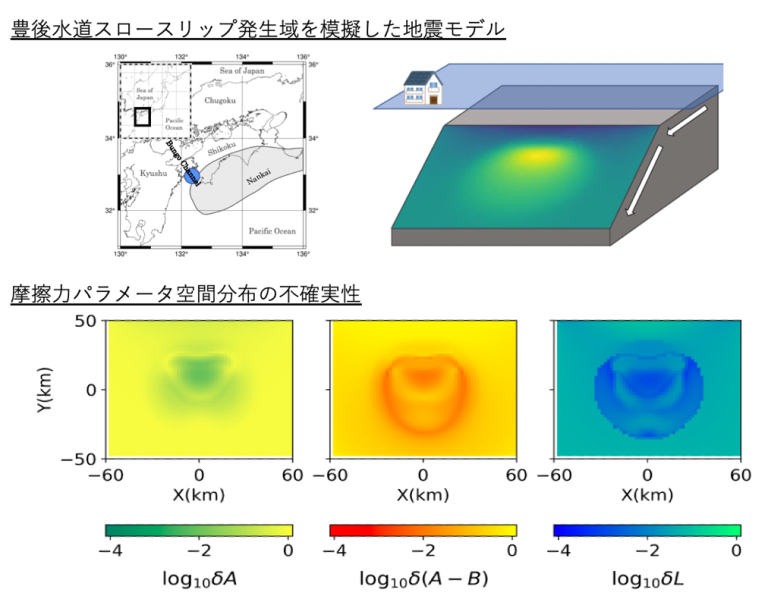
Earthquakes occur when a fault slips, and the mode of motion depends on the spatial distribution of the frictional force generated in the fault plane. Studying the details of the spatial distribution of frictional forces can greatly help in understanding the physics of complex fault movement. Since it is difficult to examine faults deep underground directly, it is necessary to estimate “what the spatial distribution of frictional forces should be for the realistically observed motion to be realized” by using the limited observational data available, and then, to estimate “where the major motion contributors are located” by evaluating the spatial distribution of that uncertainty. To achieve these goals, methods such as data assimilation, which combines simulation models of earthquakes and Bayesian statistics, have been used in recent years. However, earthquake models are generally large in scale, and existing data assimilation methods suffer from the “curse of dimensionality,” which makes these computations expensive and estimation difficult. Since this computational complexity limits the resolution of the spatial distribution to be estimated, there is a need to develop a new method to evaluate a detailed structure of the spatial distribution and its uncertainty.
In this study, we applied a new data assimilation method (Ito et al., 2021) based on recent advancements in numerical analysis to a seismic model (Hirahara et al., 2019) simulating a slow-slip zone off the Bungo Channel, and developed a method to evaluate the uncertainty of the spatial distribution of frictional force with high resolution and accuracy (Fig. 1).
This method allows the detailed structure of uncertanties to be evaluated with tractable computational complexity without limiting the resolution. The results of this research are expected to contribute not only to the physical understanding of seismic motion, but also to practical problems, such as feedback to guidelines for efficient data acquisition based on comparisons between the structure of the detailed uncertainties to be estimated and the observed motions.
See the following paper in detail.
Ito, S., M. Kano and H. Nagao, Adjoint-based uncertainty quantification for inhomogeneous friction on a slow-slipping fault, Geophysical Journal International, Volume 232, Issue 1, January 2023, Pages 671–683, https://doi.org/10.1093/gji/ggac354
Seismic-phase Detection Using Multiple Deep Learning Models for Global
and Local Representations of Waveforms
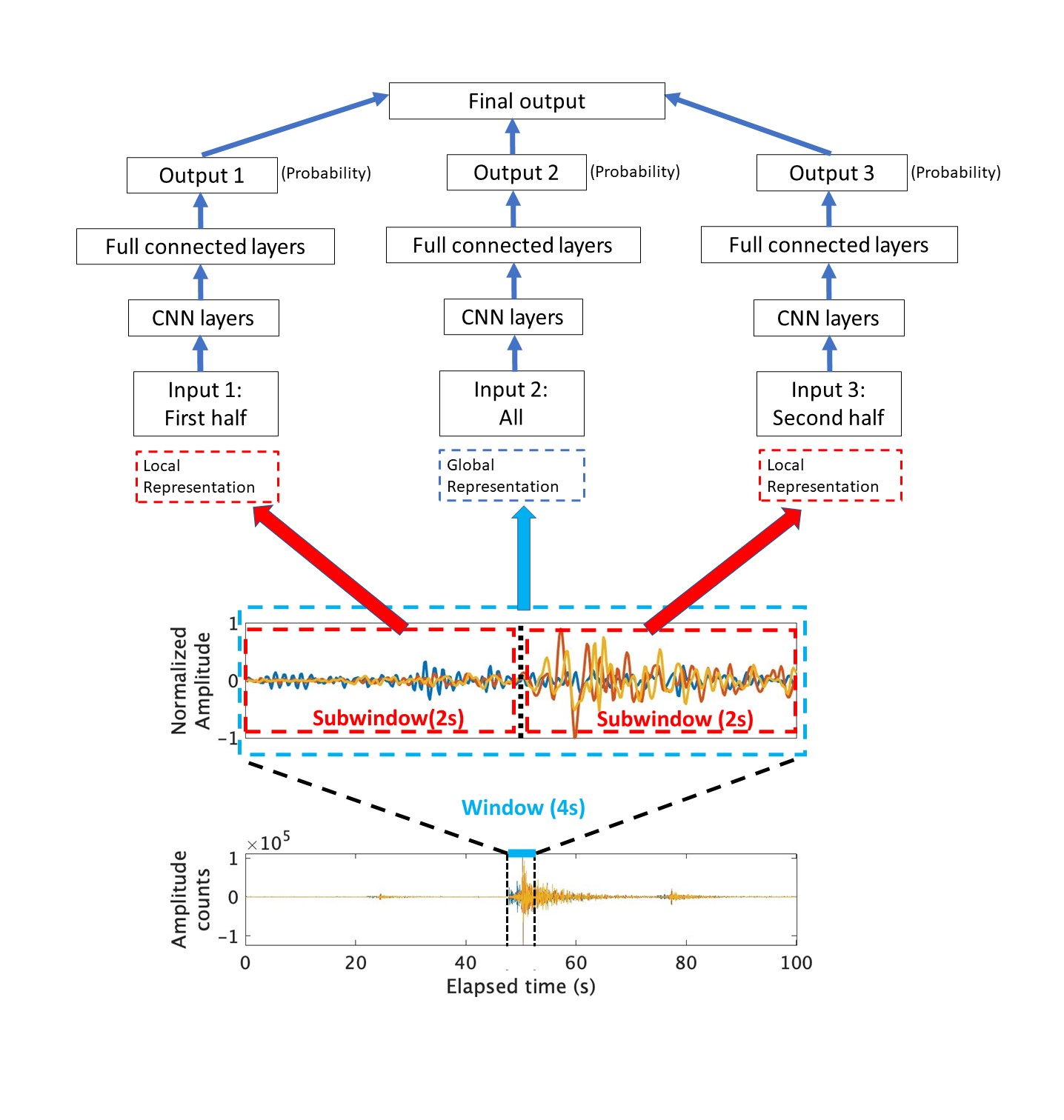
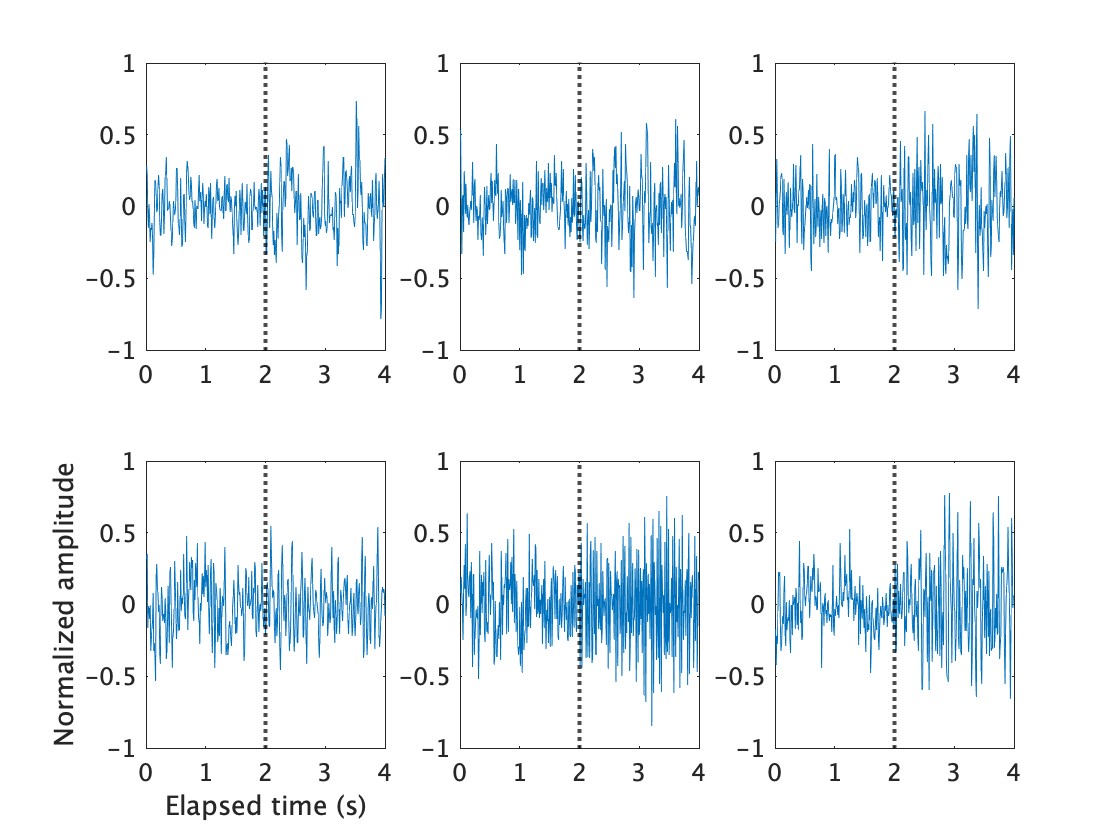
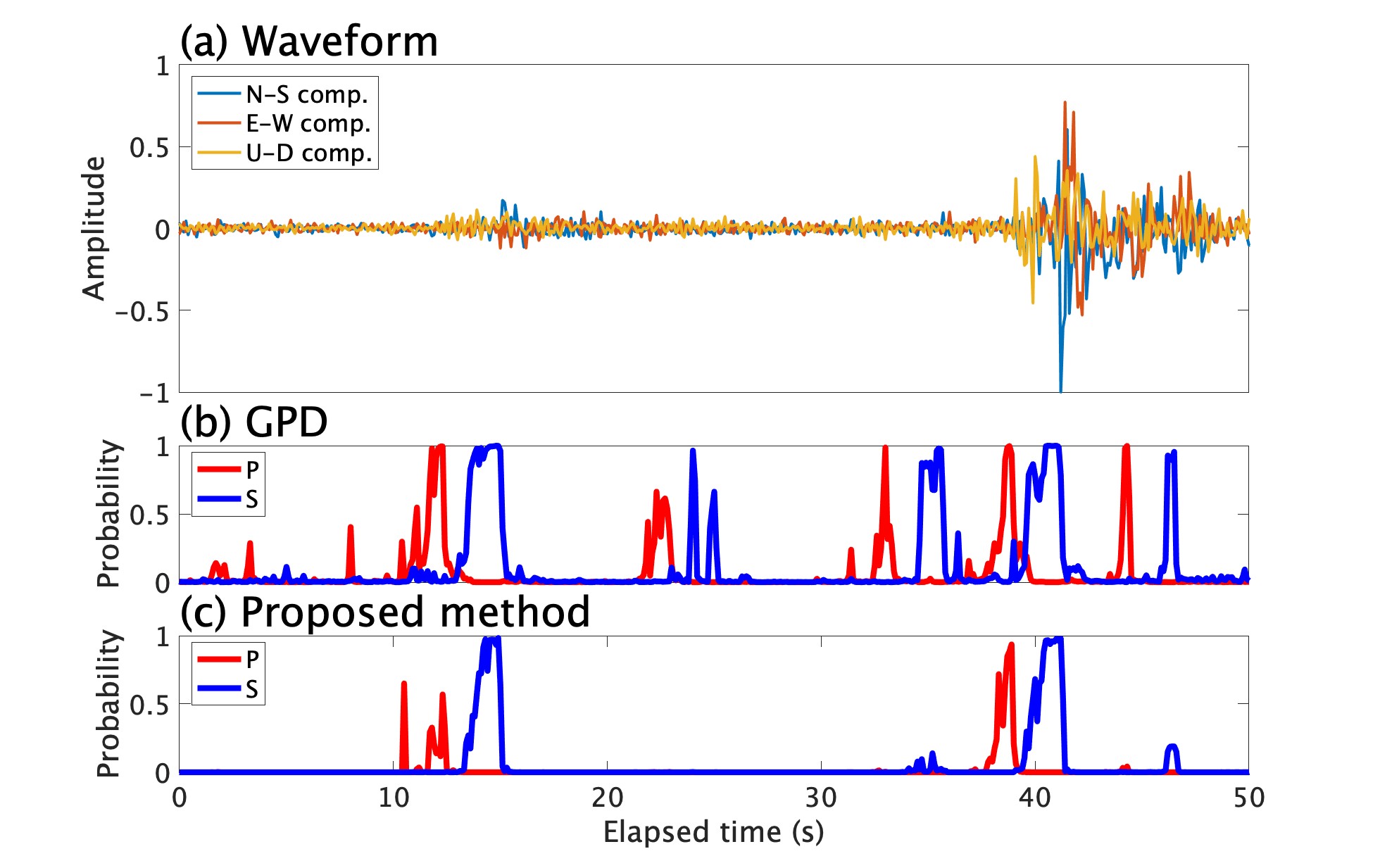
Today, earthquake detection is based on seismometers that measure ground motion. Since the ground surface is constantly shaking due to various factors including human activities, it is necessary to identify the specific shaking for seismic waves. Conventional detection methods evaluate rapid temporal changes in tremor amplitude and detect seismic waves when they exceed a threshold value. Recently, with the advent of AI technology, deep- learning-based methods have gained much attention for research and development of earthquake detection methods. An AI model is trained using a huge number of accumulated seismic wave data, which in turn enables to detect earthquakes with greater accuracy by capturing seismic wave features that have been overlooked by conventional methods.
In the present research, a new deep-learning model was developed to further improve such AI technology.
Specifically focusing on the GPD (Generalized Phase Detection) method, which was based on convolutional neural networks, we improved the detection model by taking into account both the whole and local information of the seismic waveform (Fig.1).
The basis of this idea is something we experience in our daily lives. For example, butterfly/moth and plum/peach trees are prone to be misidentified by looking at them from a distance, but can be accurately identified by gazing at the wings and flowers (local information).
Similarly, for the proposed method, seismic detection models were built for both the whole and local waveform, and the final results were obtained by integrating the detection results from each model. By explicitly incorporating (i.e., gazing at) the local information of the waveform, the model can more accurately identify waveforms that tend to be misjudged (Fig.2).
When applied to continuous waveform data, false detections were found to be reduced (Fig.3). In addition to improving detection accuracy, another important aspect of this research is that a new framework for detection models is provided, in which models are built for both the whole and local waveforms. This is expected to increase the repertoire of modeling and contribute to the development of flexible detection models suited to the target regions where earthquakes are to be detected.
See the following paper in detail.
Seismic-phase detection using multiple deep learning models for global and local representations of waveforms Geophysical Journal International, Volume 235, Issue 2, November 2023, Pages 1163–1182, https://doi.org/10.1093/gji/ggad270
